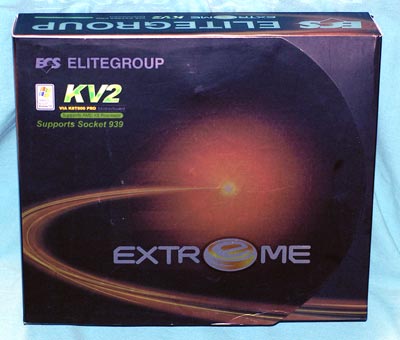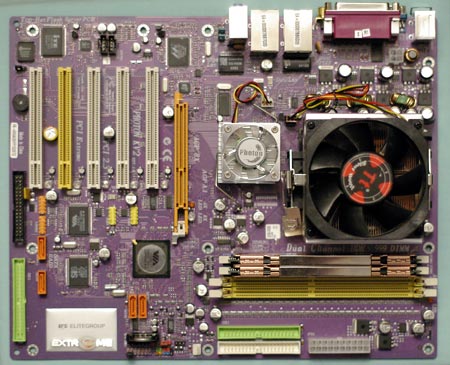Socket 939 Roundup: Battle at the Top
by Wesley Fink on July 30, 2004 8:00 AM EST- Posted in
- Motherboards
ECS KV2 Extreme: Features and Layout
| ECS KV2 Extreme Motherboard Specifications | |
| CPU Interface | Socket 939 Athlon 64 |
| Chipset | VIA K8T800 PRO/VT8237 |
| Bus Speeds | 200MHz to 511MHz (in 1MHz increments) |
| CPU Ratios | 4x - 20x in 0.5x increments |
| PCI/AGP Speeds | Disabled, 66.0, 75.4 |
| HyperTransport | 1GHz to 200MHz (5x-1x) |
| Core Voltage | 0.825V to 1.55V in .025V increments |
| DRAM Voltage | 2.50V to 2.7V in 0.05V increments |
| AGP Voltage | 1.45V, 1.53V, 1.57V, 1.60V |
| Chipset Voltage | None |
| Memory Slots | Four 184-pin DDR DIMM Slots Dual-Channel Unbuffered Memory to 4GB |
| Expansion Slots | 1 AGP 8X Slot 5 PCI Slots |
| Onboard SATA/RAID | 2 SATA 150 drives by VIA VT8237 plus 2 SATA 150 by SiS 180 Can be combined in RAID 0, 1, 0+1, JBOD |
| Onboard IDE | Two Standard VIA ATA133/100/66 (4 drives) plus 2 IDE 133/100/66 by SiS 180 |
| Onboard USB 2.0/IEEE-1394 | 8 USB 2.0 ports supported by VIA VT8237 2 IEEE 1394a FireWire Ports by VIA VT6307 |
| DUAL Onboard LAN | Gigabit Ethernet by Marvel 88E8001 plus 10/100 by VIA VT6103L |
| Onboard Audio | Realtek ALC655 6-Channel with SPDIF |
| Tested BIOS | 1.1A |

ECS hopes that the bronze-foil box with a feature flap clearly announces that the ECS KV2 Extreme is a premium board. The Extreme name is reserved for the top ECS boards, and with the Socket 939 currently a premium board, the KV2 announces that ECS wants to be a contender at the top.
The KV2 Extreme even has the individual interior boxes that we first saw on Abit motherboards, carefully fitted to protect the manuals and brackets . This should not come as a complete surprise, since ECS also manufactures some motherboards for Abit. The KV2 is a 6-layer, 3-phase design, which includes all the bells and whistles that you have come to expect from top-of-the-line motherboards. This includes Dual RAID, Dual LAN, 4 SATA ports, 2 Firewire ports, provisions for 6 IDE drives, and active North Bridge cooling.

Just so you don't miss it, ECS even has a silver plaque on the purple KV2 announcing it is a member of the Extreme series. The layout of the board is generally excellent, showing great attention to the smallest details. ECS has placed the ATX, IDE, and floppy connectors in our preferred upper right edge location. Even the extra IDE for the 5th and 6th IDE is out of the way for the PCI slots.
The BIOS adjustments on the early versions of the KV2 were very sparse, but ECS quickly updated the KV2 Extreme with the CPU Frequency adjustments, ratios, and PCI/AGP lock that you would expect on a premium 939 motherboard. Our only complaints about the available options are that the vCore is still rather meager with a top of 1.55V; 1.70 volts would have been preferred. Also, the vDIMM to only 2.7V is low for a board that intends to compete in this arena - a range to at least 2.85V and preferably 3.0V would be better.
The range of CPU Frequency adjustments to 511 is incredible, but we found that we could only use a very small portion of that frequency range. While we verified that the AGP/PCI lock is working with a PCI Geiger, we were still limited in our overclocking attempts compared to other VIA boards in this roundup.










83 Comments
View All Comments
thebluesgnr - Tuesday, July 20, 2004 - link
"Our FX53 topped out at about 3.59 GHz on the ECS KV2, which is slightly below the 3.6+ achieved on the top 939 boards."Is this ECS a P4 board? :P
This was a great article. I agree with other readers, CnQ should definately have been tested, as well as audio and IDE subsystems.
btw Wesley, will there be reviews of KT880 socket A mobos in the future?
TrogdorJW - Tuesday, July 20, 2004 - link
Just a few comments. It's a little (*little* mind you) unfair to compare FX-53 to P4 560, given the price advantage of the P4. Then again, comparing it to the P4EE is a little unfair in the other direction. It might have been nice to include one or two other systems in the benchmarks, though, like a 3400+. Sure, we can cross-reference other articles, but if you have all the data already it would be a lot cleaner. I'm especially interested in seeing AutoGK benchmarks with the "lesser" Athlon 64 processors (3500+ and 3400+ would be good, or maybe even 3200+ - not everyone has $400+ to spend on a CPU!)Of course, while it might be less fair to Intel, I would like to get AutoGK numbers using Xvid as well. That's how I use it, as I feel the quality is a little better than DivX. Oh, and while you state that you used 2-pass encoding, what was the target resolution? 640x360, or 720x408, or something else? And did you specify a target size, or was it on unlimited quality? All those are important questions, I think.
One final request: I truly appreciate the memory stress testing benchmarks. However, I would like it taken a little further. All of the boards claim that they can support up to 4 GB of RAM. I would love to see some tests showing this configuration. After all, 64-bits is really about breaking that memory barrier. Even if the boards need to run 4x1GB at DDR266 or DDR333, it would be good to know. (Too bad there simply aren't many good 1 GB DIMMs available yet.)
Wesley Fink - Tuesday, July 20, 2004 - link
#14 & #20 - Perhaps tests with the X800 XT on nF3 compared to the 6800 Ultra will at least shed a little light on where the efficiencies lie - in the nF3/nV Video combo or in the nF3 itself.#16 - We will make an effort to talk a bit more about Cool'n'Quiet in individual board reviews, but in a roundup like this it is difficult to explore that level of detail, and still hold the article length to anthing you might want to read. We try to do more with features in individual reviews.
#19 - We report the full range of vCore in our board charts for people like you who are interested in umdervolting. If you notice some boards begin vCore at default, while others make a wide undervolt range available as well as overvolt. We try to report this range as accurately as possible for this reason.
Pete - Tuesday, July 20, 2004 - link
Wesley, very interesting numbers. Halo is supposedly limited by some inefficient DX9 layers/commands, so I at first thought maybe nV had somehow optimized or bypassed some DX9 calls. The office and Content Creation benchmarks advantage is more puzzling, though. Could nV's performance edge be the result of some intelligent caching or either the HD or the CPU?Testing an X800 for reference is a good idea for Halo. Just be sure to retest the office and Content Creation suites, too, as the performance boost there is equally curious, IMO.
I found one typo, on the system specs page. It's Wolfenstein: Enemy Territory, not Wolfenstein: Enemy Within. :)
JKing76 - Tuesday, July 20, 2004 - link
Sure there's Cool'n'Quiet, but how about adding manual undervolting capabilities to the review? A lot of mobos only allow upping the vcore, but undervolting is a great tool for creating a truely cool and quiet system without losing performance.XRaider - Tuesday, July 20, 2004 - link
Love that FX53 and the MSI K8N Neo2 together. Sure is purdy nice!! ;) But must...hold...out...until...price..drops...some..more.. ;o)Great article BTW!
XRaider - Tuesday, July 20, 2004 - link
Love that FX53 and the MSI K8N Neo2 together. Sure is purdy nice!! ;) But must...hold...out...until...price..drops...some..more.. ;o)Great article BTW!
jojo4u - Tuesday, July 20, 2004 - link
I miss information about Cool'n'Quiet. It's a shame that anandtech.com only is insterested in overclocking and speed.esSJae - Tuesday, July 20, 2004 - link
Nice, another article touting the non-existent MSI K8N Neo2.Sure, you can go to MSI's Taiwan site and download the manual and BIOS, but doesn't seem to be much point in that.
DAPUNISHER - Tuesday, July 20, 2004 - link
"We never expected the nVidia nForce3-250 Ultra to be a better performer in Winstone benchmarks than the VIA K8T800 PRO. However, both the nF3-250 boards are outperforming the VIA boards by a significant percentage. Since the nVidia 6800 Ultra video card was used for all benchmarking in the roundup, we plan to verify these results with an ATI X800 XT as soon as that board is available to the Motherboard Lab for testing"Is this to determine if it's a result of forceware opts that is responsible for the difference observed?